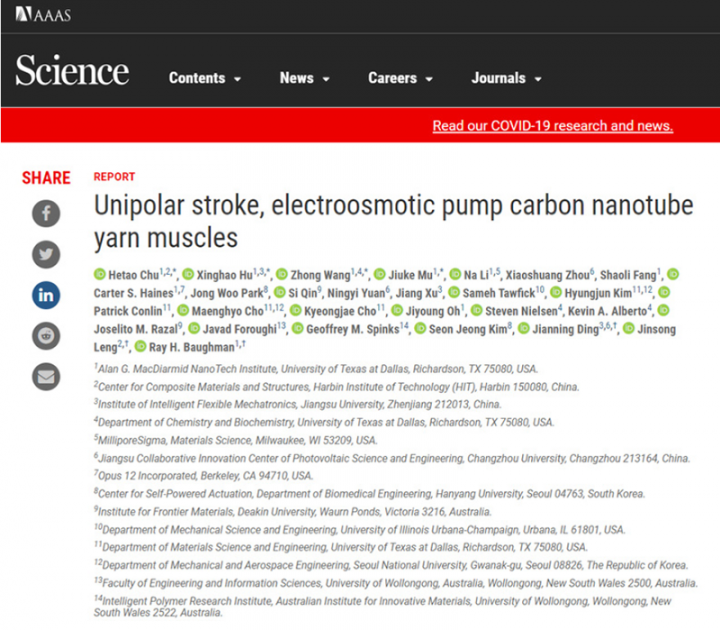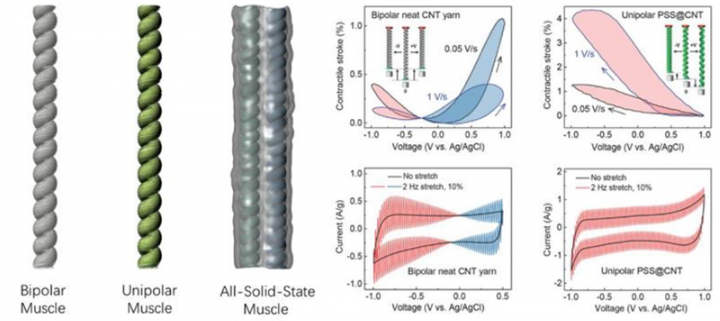On January 29, HIT made cooperation with the University of Texas at Dallas, Jiangsu University, Hanyang University of South Korea, University of Wollongong of Australia, etc. In this cooperation, it was discovered for the first time that the "Bipolar" drive of artificial muscle smart materials could be transformed into "Unipolar" drive through a polyelectrolyte functionalization strategy, and that the paradoxical phenomenon of increased drive performance of artificial muscle with decreased capacitance (Scan Rate Enhanced Stroke, SRES) was discovered.This important breakthrough addresses the capacitance dependence of artificial muscle drive performance and provides a new theoretical basis for the subsequent design of high-performance drivers with non-toxic, low drive voltages. The research results, entitled "Unipolar-Stroke, Electroosmotic-Pump Carbon Nanotube Yarn Muscles", were published online in the prestigious academic journal Science, with HIT as co-corresponding author and co-first author, including professor Leng Jinsong of HIT as co-corresponding author (Ding Jianning of Jiangsu University; Leng Jinsong of Harbin Institute of Technology; Ray H. Baughman of the University of Texas at Dallas, USA) and his PhD graduate Chu Hetao as co-first author (Chu Hetao, Hu Xinghao, Wang Zhong, Mu Jiuke).
At present, new materials are developed from lightweight and multifunctional to intelligent. Smart Materials are a new class of materials that can respond actively to external stimuli and have a variety of functions such as self-driving, self-monitoring and self-healing, and have a wide range of applications in artificial intelligence, smart manufacturing, biomedicine, robotics and other fields. Polymer fibres with carbon nanotube yarns artificial muscles are a typical smart material that is mainly driven by both thermal and electrochemical means. According to the law of thermodynamics, thermal drive is limited by Circulation efficiency in Kano, which affects its application potential. In contrast, electrochemical driving overcomes the limitation of Circulation efficiency in Kano and has higher energy conversion efficiency, which has a broader application prospect.
The traditional electrochemical carbon nanotube yarn artificial muscle has the following limitations: (1) The process of anion embedding and ingrowth results in a "bipolar" effect between the driving strain and the scanning voltage, which means that the fibre size does not vary monotonically within the electrochemical window and that the driving strain is offset by the embedding and ingrowth of the reverse ions, thus reducing the driving performance of the artificial muscle. (2) The performance of the artificial muscle is entirely dependent on the capacitive characteristics of the working electrode, i.e. the performance decreases sharply with increasing scan rate. As a result, conventional artificial muscles can only produce unidirectional drive and need to operate at very low scan rates.
To solve above problems, this study changed the zero potential of artificial muscle through a functionalization strategy of polyelectrolyte (zero potential moving reagent) : (1) This research realizes the "unipolar" effect of single ion embedding and embedding, solves the problem of performance degradation caused by the embedding and embedding of reverse ions of "bipolar" effect, and improves the performance efficiency and energy density, etc. (2) With the increase of scanning rate, the driving performance of artificial muscle increases, realizing the SRES effect and solving the capacitance-dependent problem of the driving performance of traditional artificial muscle. Further studies showed that the SRES effect was due to the fact that hydrated ions could drive the surrounding water molecules at high scanning rate or pulse frequency, thus increasing the effective size of ions and improving the performance of artificial muscle.
Compared with the traditional artificial muscle, the artificial muscle has the advantages of non-toxic, high driving frequency (up to 10 Hz), low driving voltage (1 V), high specific energy (0.73 ~ 3.5 J / g), high driving strain (3.85 ~ 18.6%) and high energy density (up to 8.17 J / g) W / g), which has great application potential in space deployment structure, bionic flapping wing aircraft, deformable aircraft, underwater robot, flexible robot, wearable exoskeleton, medical robot and other fields.
Under the leadership of academician Du Shanyi and academician Han Jiecai, the Institute of composite materials and structures of HIT established the research direction of intelligent materials and structures earlier in China in the early 1990s.Professor Leng Jinsong's research group has been engaged in the structural mechanics and Application Research of smart materials for a long time. The main research directions include shape memory polymer and its composite structure, artificial muscle, multifunctional nano composite structure, space deployable structure, deformable aircraft, flexible robot, 4D printing technology and biomedical devices, structural health monitoring, active vibration control, etc.
Article links:https://science.sciencemag.org/content/371/6528/494

Article screenshot

Comparison of artificial muscle types and driving characteristics of "unipolar" and "bipolar"


